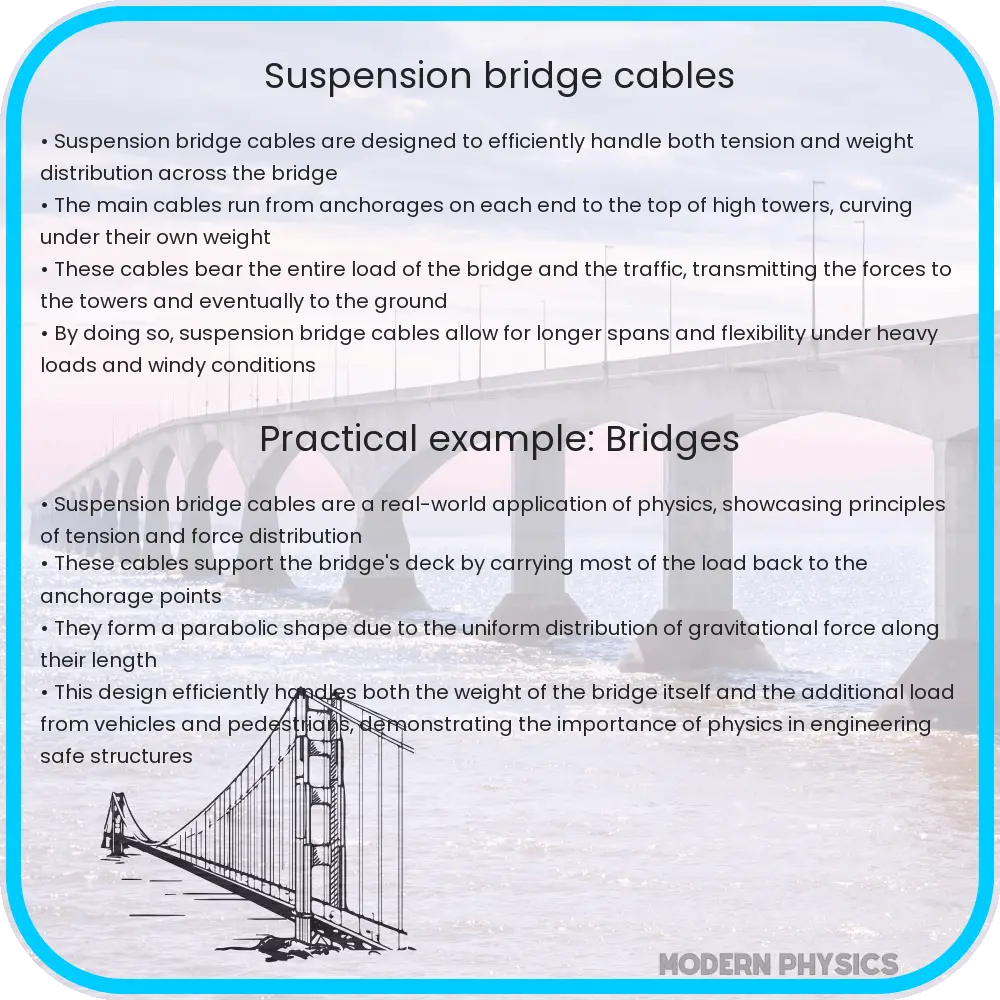Explore the strength, design, and statics of suspension bridge cables, from material innovation to maintenance challenges and future technology.

Suspension Bridge Cables: Unveiling the Core of Strength and Design
The marvel of modern engineering, suspension bridges, owe their strength and resilience to the intricate design of their cables. These cables are not only pivotal in sustaining the weight of the bridge and the traffic it carries, but also in ensuring its stability against natural forces like wind and earthquakes. This article delves into the principles of strength, design, and statics that govern the construction of suspension bridge cables.
Understanding the Strength of Suspension Bridge Cables
At the heart of a suspension bridge’s strength lies its cables. Typically made from thousands of individual steel wires bound together, these cables exhibit exceptional tensile strength – the ability to withstand pulling forces. The composition of these cables often involves high-grade steel, characterized by its high carbon content, which lends the material its remarkable strength and durability. Advanced metallurgical techniques have further enhanced the strength-to-weight ratio of these cables, making modern bridges more robust and lighter.
Design Principles of Suspension Bridge Cables
The design of suspension bridge cables is a meticulous process that balances aesthetics, aerodynamics, and structural integrity. The cables must be designed to handle not only the static weight of the bridge and its load but also dynamic forces like wind and seismic activities. Engineers use complex mathematical models and simulations to predict these forces and design the cables accordingly. A key aspect of the design is the ‘cable sag’ – the natural curve formed by the cable under its weight and tension. This sag is crucial in distributing the loads evenly across the cable’s length.
Statics Principles in Suspension Bridge Cable Design
Statics, the branch of mechanics that deals with bodies in equilibrium, plays a vital role in the design of suspension bridge cables. The principles of statics ensure that all forces acting on the bridge are in balance. For a suspension bridge, these forces include the tension in the cables, the gravitational pull on the bridge deck, and external loads such as vehicles. Engineers employ statics principles to calculate the optimal tension in the cables, ensuring the bridge remains stable and secure under various load conditions.
The application of statics is evident in the formula for cable tension (T), given by T = wL2/8d, where w is the uniform load per unit length, L is the span of the cable, and d is the sag. This formula underscores the interplay between the load, span, and sag in determining the cable’s tension.
Continuing, we will explore the materials used in suspension bridge cables, their maintenance challenges, and the future of suspension bridge technology.
Materials Used in Suspension Bridge Cables
The choice of materials for suspension bridge cables is critical for their performance and longevity. While steel remains the predominant material, due to its excellent tensile strength and durability, advancements in materials science have led to the exploration of newer materials. One such promising material is carbon fiber reinforced polymer (CFRP), known for its high strength-to-weight ratio and resistance to corrosion, offering a potential alternative for future bridge designs.
Maintenance Challenges of Suspension Bridge Cables
Maintaining the integrity of suspension bridge cables is a significant challenge. Exposure to environmental factors like moisture, salt (in coastal areas), and temperature fluctuations can lead to corrosion and fatigue in the steel wires. Regular inspections and maintenance strategies, such as dehumidification systems and protective coatings, are essential to prolong the life of these cables. Moreover, modern sensor technologies enable real-time monitoring of cable tension and stress, aiding in timely maintenance and repairs.
The Future of Suspension Bridge Technology
The future of suspension bridge technology is shaping up to be an exciting blend of innovative materials, smart monitoring systems, and sustainable designs. With the advent of new materials like CFRP and the integration of smart sensors, future suspension bridges are expected to be lighter, stronger, and more resilient to environmental challenges. Sustainable design practices, focusing on minimizing environmental impact and maximizing energy efficiency, are also becoming integral to the development of new suspension bridges.
Conclusion
Suspension bridge cables represent a pinnacle of engineering achievement, combining principles of strength, design, and statics to create structures of awe-inspiring beauty and enduring stability. From the meticulous selection of materials to the intricate design considerations and the application of statics principles, every aspect of these cables is a testament to human ingenuity. As we look forward, the continuous evolution in materials and technology promises even more impressive feats in suspension bridge construction. These bridges are not just pathways connecting places; they are symbols of our ability to overcome natural challenges through science and creativity, standing as monuments to human endeavor and progress.
